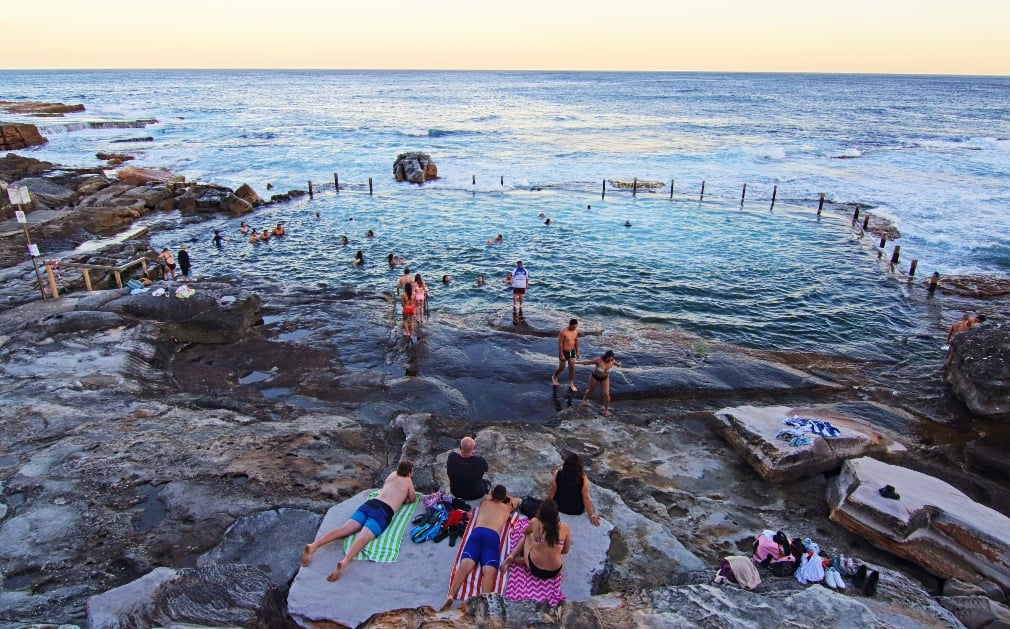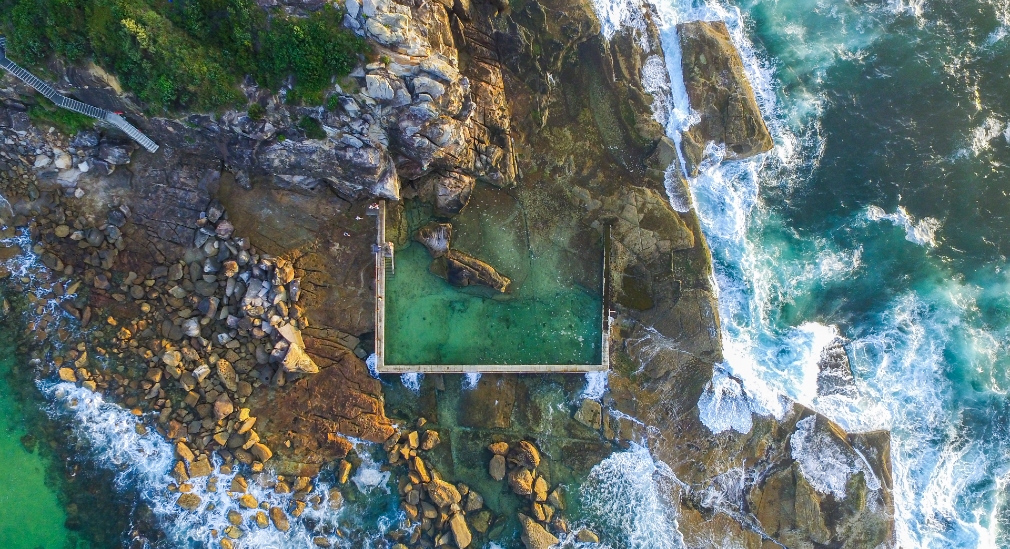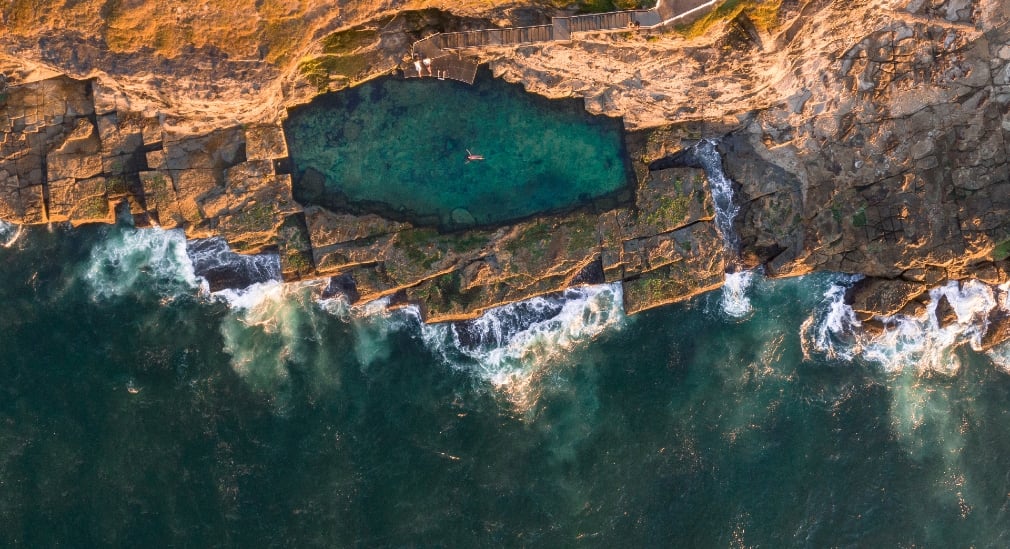The National Trust (NSW) has heritage listed a diverse range of places throughout New South Wales – including many rock and ocean pools. Here are five of the best natural pools around Sydney that are on our register and are a must-swim for summer.
In 1994, the National Trust commissioned a survey of Sydney’s ocean and harbour pools, which led to five ocean pools being recognised on the State Heritage Register.
The ocean pools of NSW are often carved into the rock shelves along our coastlines, many with pre-colonial history as naturally forming rock pools and fish traps used by First Nations people. Ocean bathing gained popularity around the turn of the century, as open swimming and gender segregation laws were repealed, allowing beachgoers to mingle and swim at their own leisure.
As beach swimming and the surf lifesaving movement become more popular throughout the early 1900s, local councils began constructing ocean pools as a form of social and community investment. This was especially prevalent throughout the 1930s as a form of government funded public works to provide economic relief to regional areas during the Great Depression.
Today, these ocean pools continue to remain beloved gathering spaces, with most of their significance associated with ongoing social and recreational value, rather than simply the design and fabric. The largest threat to the heritage of ocean pools in contemporary times is climate change, with rising sea levels and the increasing occurrence of natural disasters.
Well-maintained ocean pools continue to live on as a classic part of the Australian summer experience. The five pools below show a range of the pools we work hard to protect, conserve, and cherish.
Mahon Pool
Mahon Pool is tidal pool located between Maroubra and Coogee beaches. Great for swimming laps, frolicking in the sun and gentle enough for a nice float, Mahon Pool is a fantastic location for a picnic with your loved ones. It features a stunning view over the ocean towards Sydney’s south, and is a perfect place to watch the sun rise or set. On a summer weekend you’ll find a mix of early morning lap swimmers in the pool and sunbakers spread along the rocks.
Mahon Pool was built in the 1930s, making it almost a hundred years old. It was first listed with the National Trust in 1994, stating it had “high aesthetic value due to its siting and the manner by which the pool tends to ‘melt’ into the rock platform; and it is a popular local landmark and meeting place for local residents.”

Shelly Park Ocean Pool
Shelly Park Ocean Pool is located in The Esplanade, Cronulla, and was first listed by the National Trust in 1994. The pool is located on a rock shelf, with three walls of concrete and one open to the beach above. Records indicate that the location was identified as a great site for a pool as early as 1908, but nothing was developed until 1938, when the depression stimulus program funded £1300 for its construction. Over 80 years later, it has remained a consistently popular swimming and social gathering space.
Shelly Park Ocean Pool is a great family destination; it is located close to the playground, with amenities provided at the pavilion, surrounded by open space, and accessible to more beaches further along The Esplanade.
North Curl Curl Rockpool
Located at Dee Why Head, the North Curl Curl Rockpool is a little bit more of a challenge to visit. Access to the pool is along the rocky outcrop of the beach, and at high tide only through the coastal walk along the headland.
The challenge, however, is well worth the reward, with stunning views across the beach and south to greater Sydney. Where the pool is small in size (being only 35×23 metres) it is large in character, featuring a natural wall to the rock face, central outcrop islands and plenty of surrounding crevices to explore ocean wildlife.
Like Shelley Park and Mahon pools, the North Curl Curl one was developed in the 1930s as part of the Depression infrastructure investments. It was, however, badly damaged by big seas in the 1950s, leading to its reconstruction in the mid-century. The National Trust listed North Curl Curl Rockpool as part of the study in 1994, assessing it to have “high aesthetic appeal because of its location towards the tip of the headland” and indicating significance regarding its incorporation of natural landforms.

The Bogey Hole Newcastle
Located a little bit further north than the other pools, the Bogey Hole Newcastle (formerly the Commandant’s Bath) is well worth the day trip from Sydney. Originally constructed for the personal use of the military commandant of Newcastle, Major James Morrisett, the bath was hewn out of the rock platform below Shepherd’s Hill circa 1820. A semi-circular path known as the horseshoe was also hewn directly down from the commandant’s residence to the pool.
The work to construct the Bogey Hole was most likely completed by convict labour, and is thought to be Newcastle’s earliest surviving man-made structure, and the earliest known example of a purpose-built ocean swimming pool in the country.
The pool was opened to the public in the 1860s, and has remained a popular community space ever since. Its penal history, age and location make it a very rare and significant item in Australia’s coastal history, and it was listed by the National Trust in 1979.
The Bogey Hole design is distinctive and unusual – being hexagonal and almost coffin-like in shape, and with direct cut into the rock face rather than the concrete walling common to other ocean pools.
The Bogey Hole is a great destination to visit, with the King Edward Park located directly above and the Newcastle CBD just a short walk away. The Bogey Hole is also located between two other beloved ocean pools, the Merewether Ocean Baths to the south and the Newcastle Canoe Pool and Ocean Baths to the north (Newcastle Ocean Baths temporarily closed for refurbishment – planned for reopening mid 2023).

Avalon Rock Pool
Avalon Rock Pool is located at the southern end of Avalon Beach, and is made up of two sections – one a small square for wading and the other a larger trapezoid for lap swimming. Originally a natural pool on the rock face, it was excavated and concreted in by the local council in the 1920s. Further alterations and safety amenities were conducted in the 1960s.
The National Trust Register describes it as significant for its “aesthetic appeal because of its dramatic siting between the rock face and open sea”. More than two decades later, it remains just as beautiful, with sweeping beach views to the north and sea views to the east. It’s a great place for the whole family, with the option for a workout in the big pool or a gentle wade in the small.
Find out more
The National Trust (NSW) has been campaigning to protect NSW’s built, cultural and natural heritage for over 75 years. Find out more about our advocacy work.
Stay up-to-date on future advocacy news
Subscribe to our free monthly e-newsletter to hear about our latest advocacy efforts for protecting NSW heritage.

 Twitter
Twitter Facebook
Facebook Linkedin
Linkedin Email
Email
Thanks National Trust people for this interesting read. Congrats on the very detailed submission against the raising of the Warragamba Wall, a great submission and hope the government changes its mind not to proceed! I also loved the read on the various rock pools which has changed my thinking about these great locations and why they are lisedt.
NSW Heritage Ocean Pools article- I was surprised that Blue Pool in Bermagui wasn’t in the article or do you only cover Sydney and surrounds?